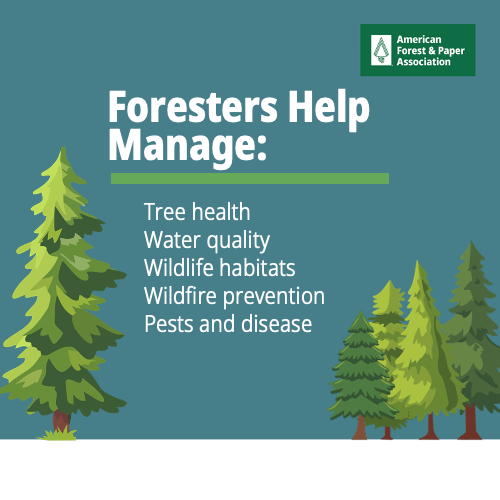What is Biodiversity?
Registered Foresters from Across the U.S. Explain the Importance of Biodiversity
Key Takeaways
This is part 3 of our forest management series. Explore part 1, “What is Sustainable Forestry” and part 2, “What Are Forest Management Practices?” Sustainable forestry and forest management practices work together to maintain biodiversity.
What is Biodiversity?
Biodiversity in a forest is more than how many different species of animals live there. It also includes the soil, bugs, trees, flowers, fish, fungi like mushrooms and more.
Different species need different conditions to survive such as:
- Temperature
- Shelter
- Food and water sources
The different structures of managed forests offer diverse habitats for wildlife and plant species.

The Foresters Take:
Neal Carson, Timber and Forestry Manager, Packaging Corporation of America in Tennessee
"Biodiversity refers to the variety of life forms within an ecosystem, including the diversity of species, genetic diversity within species, and diversity of ecosystems themselves.
It encompasses the wide range of plants, animals, fungi, and microorganisms that inhabit Earth, as well as the interactions between them and their environments.”
Cierra L.S. Ward, Forestry Manager, Resource Management Services in North Carolina
"Biodiversity means having multiple species of healthy plants and animals present across the landscape.”
What’s an Example of Biodiversity in a Forest?

Managed forests are often in different stages of the tree life cycle. The differences can include:
- Tree age
- Tree height
- Tree species
These differences contribute to biodiversity. This means differences in the animals, plants and stand structure. The location of a forest also affects biodiversity. Just like growing a garden in the Pacific Northwest is different than growing a garden in the Southeast U.S.
The Foresters Take:
Cierra L.S. Ward
"For example, in the south, a young managed forest where the pine trees have not yet grown very tall provides the perfect environment for blackberries, goldenrod, and thistles to thrive. Those plants support multiple songbirds, pollinators, wild turkey, black bear, and deer.
The rotting woody vegetation from the previous forest stand provides habitat for reptiles and amphibians, as well as decomposers like worms, ants, and mushrooms.
In an older managed forest, where the pine trees are very tall and the forest floor is shaded, many grasses grow. This provides excellent forage for deer and quail as well as nesting habitat for turkeys and hunting opportunities for animals such as raccoons, possums, and foxes.”
Why is Biodiversity Important?
Biodiversity is crucial for a healthy ecosystem. Each species has a job they perform to maintain the balance of the ecosystem. Different species work together to maintain the conditions necessary for their collective survival.
Let’s take pollinators for example. Flowering plants and wildflowers are a food source for many pollinator species, like bees and birds.
These animals help transfer pollen across the forest every time they eat. This helps the plants reproduce and maintains a healthy ecosystem.
The plants also attract other insects that are a food source for birds and other animals. All of this helps with reforestation and biodiversity.
Maintaining biodiversity ensures forests can provide us with our essential products and provide species with their vital resources.
The Foresters Take:
Neal Carson
"Biodiversity is essential for ecosystem stability, resilience, and functionality, as it supports ecosystem services such as nutrient cycling, pollination, pest control, and climate regulation. Protecting biodiversity is crucial for maintaining healthy ecosystems and ensuring the well-being of both human societies and the planet.”
How Does Forest Management Help Maintain Biodiversity?

Forest management plays a large role in maintaining biodiversity. Foresters help maintain and create habitats for wildlife and plant species. They do this through using responsible forest management practices.
Some practices that help maintain biodiversity include:
- Reforestation and replanting
- Wildlife habitat creation and enhancement
- Managing for water quality
- Selective harvest
- Disease and pest management
- Fertilizing the soil
- Controlled burns, also called a prescribed fire
- Monitoring and research
The Foresters Take:
Carolyn Mulligan, District Manager, American Forest Management in Virginia
"Sustainable forest management means we manage our forests in a way to ensure those forests can provide the planet with life essential things like clean air and water, beautiful landscapes, diversity of species and the forest products that enhance our lives and provide us comfort.”
Cierra L.S. Ward
"Managed forests benefit wildlife in many ways. When managing forests, we often create openings that edge-loving species utilize to hunt for food or prey or use as travel corridors... We often leave mast-producing trees and shrubs, like oaks and blackberries, that provide excellent food for wildlife.”
Neal Carson
"Yes, managed forests can benefit wildlife in several ways. These may include habitat diversification, food and shelter enhancement, increased conservation efforts, and by allowing better monitoring and research.”
Interested in Learning More About Sustainable Forestry?
Want to learn more about sustainable forest management in the U.S.? You can:
- Learn about International Paper’s work to enhance bird habitats in working forests.
- Take a virtual forest tour to see how managed forests operate with Georgia-Pacific.
- Contact your state’s forestry association or Department of Forestry.
- Learn about the Sustainable Forestry and Land Retention Project
